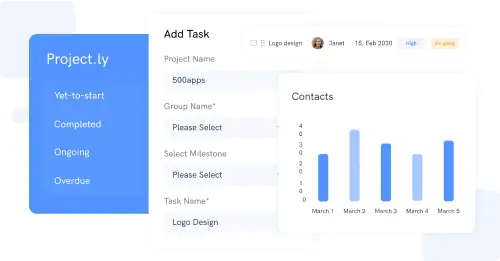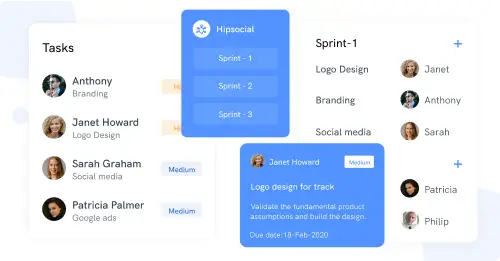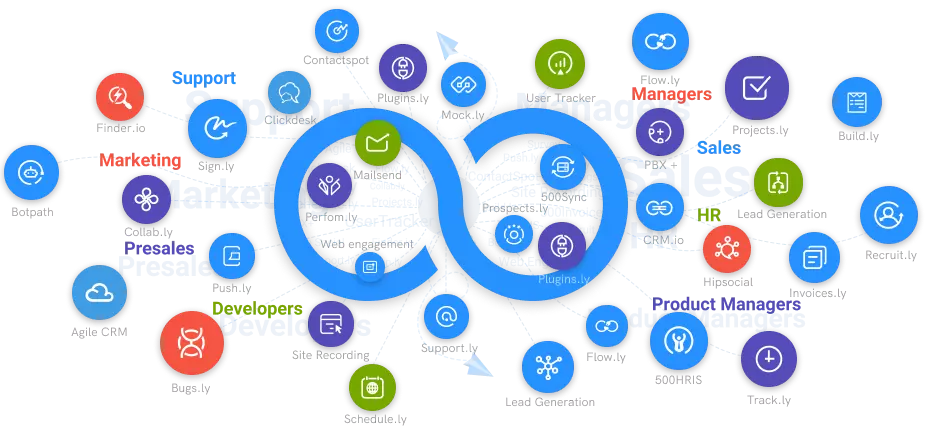Best Methodologies of Project Management Tool
Choose the best project management methodology that meets your organizational needs and manage your tasks easily.
#1
Plan, organize, track all your projects in one place
#2
Get a visibility over individual tasks in the form of kanban boards
#3
Track the project schedule using gantt chart and calendar view
#4
Create advanced workflows with powerful automations
#5
Track employee activities, and working hours using built-in time tracking software, Clockly
#6
Monitor activities using screen recorder on Windows, Mac and Linux devices
#7
Set S.M.A.R.T goals and achieve results
#8
Share files and collaborate with team through discussion boards
#9
Unbelievable pricing - the lowest you will ever find
#10
Everything your business needs - 50 apps, 24/5 support and 99.95% uptime
Most of us are aware of the Project Management Tool and its role in any organization. Every respective manager knows that it is crucial to select the proper methodology to make the job perfect. Also, the landscape of Project management methodologies is a bit overwhelming. There is an abundant count of project methodologies if you have earned a formal Project management certification to become the best project manager and looking to choose the right one.
Project methodologies often come with their own set of rules, principles, lists and acronyms. Let us know how to choose the right methodology for your project in detail.
What is Project Management Methodology?
According to the Project Management Institute - PMI, a Project management methodology is defined as a system of techniques, practices, procedures, and tools, which are used in a disciplinary manner. These processes aim to assist the project managers in guiding the project and the essential steps that should be taken for the task completion.

Various methodologies have various strategies that aid in the issue management and they should arise in the delivery of the project.
How to Choose the Right Methodology?
The point of selecting the right or suitable methodology is to maximize the use of time and resources. In fact, there is no term indicating the right methodology. We should go with the one from the available and effective ones that match our project. As we said, projects differ as per the scope and requirements; the same theme applies to the methodology.
Besides this, let us look at the key considerations that can help you to choose a suitable methodology.
1. Budget
Identify what sort of budget that you fall into. And, in addition to this, consider the possible factors such as what if in case the budget is not sufficient and what action to be taken if that case arises?
2. Team Size
Every project manager needs to estimate the required resource and the stakeholder count for the completion of a project. Check twice that your team is self-organizing and relatively compact.
3. Flexibility
What if the project should be moved completely to the other process? What should we do with the completed project? These are the few key points to consider during, before and after the project.
4. Risk-taking ability
At times, situation might come up that you need to take some risks on your project. They may include: Can we implement the very new tool or feature that was released very recently in the market.
5. Timeline
How much time does it take to deliver the overview? Do we need a quick turnaround time? Does it take much longer than expected to get the desired result, no matter how long it takes?
6. Stakeholder collaboration
How to and how far can we involve the stakeholders in our project?
Different Project Management Methodologies
As we discussed already, there are many project methodologies in Project Management Software to look into. Let us look at a few of them that help to scale up your project.

1. Agile
Agile is the more recognizable Project management methodologies. It is best suited for projects with the type of incremental and iterative. This is a process type where the demands and their respective solutions evolve through the collaborative effort of self-organizing and cross-functional teams, including their customers.
It was created actually for software development and was established as a response to the inadequacies contained in the Waterfall method, which did not meet the demands of the highly competitive and constant movement of the software industry.
Agile Project Management stems from the principles and values of the Agile Manifesto. The purpose of this model is to uncover better ways of developing software by providing a clear and measurable structure that fosters team collaboration, iterative development and change recognition.
Ideal for:
This model is suitable for projects, which need flexibility and has uncertainty and complexity levels. For example, the product/service, which has not been built by the team.
2. Waterfall Model
The waterfall is also a traditional Project management methodology. It is a linear and sequential design model, where the progress flows from upwards to downwards (same as a waterfall). This model originated in the construction and manufacturing industries. It lacks flexibility in the initial stages of the design changes in the development process because it is becoming more expensive in an exuberant manner because of its structured physical environment.
This model is comprised of the phases: System and software requirements Analysis Design Coding Testing Operations
This model stresses the importance of documentation. The idea is that, assuming that a person involved in a development process has left, their substitution can start at the same point where he left. This can be achieved by familiarizing themselves with the documented information.
Ideal for:
This methodology is best suitable for the larger projects that need stringent maintenance stages, deadlines, or projects done multiple times over where the surprising changes during the development process are relatively low.
3. Scrum Methodology
Scrum is also defined as a form of agile methodology. Instead of a Project management methodology, you can think of it more as a framework. Here, you can split the project into shorter cycles, called sprints. They usually last for 1-2 weeks. For each sprint iteration, the works are taken from the backlogs (the upcoming or to-do tasks).

Smaller teams are organized by Scrum Master (not like a project manager) for the sprint duration. After that, they are reviewed in the “sprint retrospective” and can make necessary changes before the sprint starts.
Some of the events in the Scrum include:
Sprint - Iterative timeboxes, where the goal is accomplished. Here, the time frame does not exceed one calendar month.
Sprint planning - The point where the entire Scrum meets, from the beginning of every sprint to plan the upcoming sprint.
Daily Scrum Call - 15-30 minute boxed meeting held on a recurring basis on every day of the sprint where the previous day tasks and the current day to-do tasks are discussed.
Sprint review - This is an informal meeting held at every end of the sprint, where the team showcases their increments to the stakeholders and discusses feedback.
Sprint retrospective - It is a meeting where the team reflects their proceedings of the previous sprint and regulates improvements in the next sprint.
Ideal for:
Projects that are associated with less team count require a flexible approach in delivering a product or service.
4. Kanban
This is another methodology following Agile Project Management. This also originated from the manufacturing industry. The term “Kanban” has evolved to indicate a framework, where the tasks are represented visually with their progress using a Kanban Board. Works are continuously pulled from the pre-defined backlog as the team has the capacity and moves through the board columns.
Each of these columns represents the stage of the process. This model is great to provide an immediate visual representation, indicating where the work stands at. In addition, it helps to identify the bottlenecks before the risk is about to form. For example, if one of your stages needs to be re-examined.
It was developed on the production line of Toyota factories in the 1940s, aiming to deliver high-quality results by representing it in a pictorial form. In general, it opiates on six general forms, which are:
- Visualization
- Limiting work in progress
- Flow management
- Making policies explicit
- Using feedback loops
- Experimental or Collaborative evolution
Ideal for:
Like Scrum, Kanban also fits for the projects associated with smaller teams. This is also great for the personal productivity process.
5. Scrumban Methodology
It is a combination of Scrum and Kanban, where a few call it a cross-breed. Scrumban is defined (in a layman understanding) as a Hybrid Agile Project Management Methodology with Kanban’s head and Scrum’s tail.
The primary benefit of the Scrumban is instead of deciding on which task to be performed in each sprint from the backlog, Scrumban enables you to “pull” from the backlog continuously based on their capacity. And, with the work in progress limits (from Kanban) during the sprint cycle (from Scrum), you can organize a continuous flow while still executing the planning, reviews and retrospectives, whenever needed.
Ideal for:
This methodology is ideal for the one who wants to include both Scrum and Kanban features.
Conclusion
As we have already discussed, a suitable Project management methodology can elevate your project more significantly and help the project managers to get the most out of each team. Whichever methodology you prefer, there is a Project management methodology for each team. Also, you need a flexible, collaborative and easy-to-use Project management tool to support you at every stage of the project, no matter which methodology you have selected.
Choosing the Project Management Tool like Projectsly that supports multiple technologies means that it does not lock you at any step of your development process and elevate your company standards in most cases. It also helps the management measure the progress of the work per one resource and calculates the total productive hours spent on every single stage.





